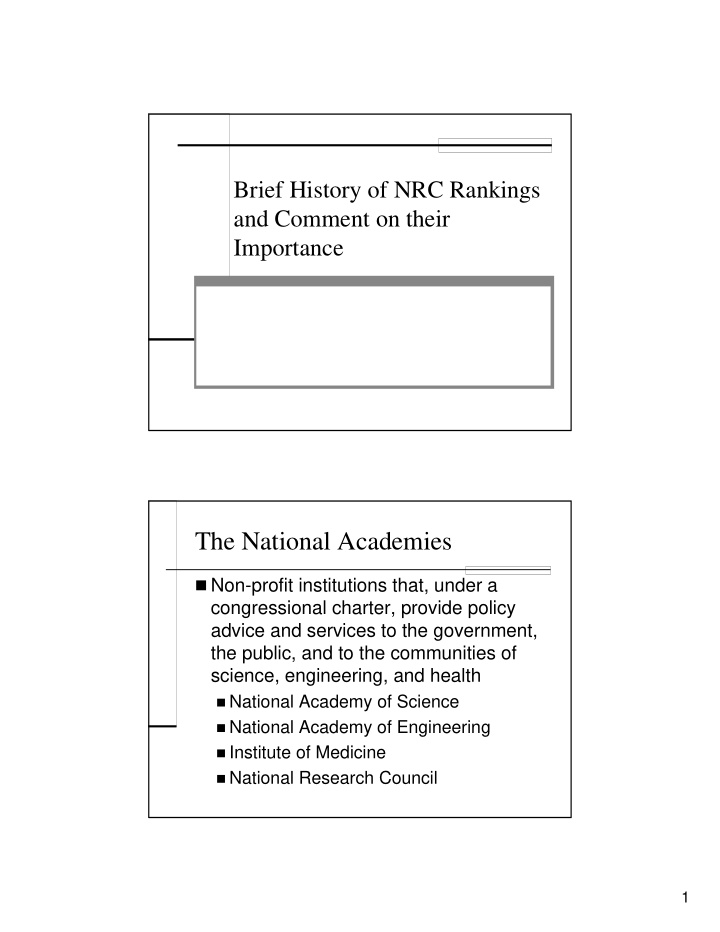



Brief History of NRC Rankings and Comment on their Importance The National Academies � Non-profit institutions that, under a congressional charter, provide policy advice and services to the government, the public, and to the communities of science, engineering, and health � National Academy of Science � National Academy of Engineering � Institute of Medicine � National Research Council 1
National Research Council � Established in 1916 � NRC has become the principal operating agency of both the National Academy of Sciences and the National Academy of Engineering � Beginning in 1983, the NRC has evaluated research doctorate programs about every 10 years (most recently in 1995) NRC Evaluations/Rankings � Began primarily as a ranking base on reputation � Have become increasingly quantitative � The current ranking will be entirely quantitative � Very detailed methodology that clearly surpasses that in similar ranking efforts 2
Concerns of CCPTP with the NRC Methodology � Current evaluation process began with the development of a taxonomy of fields and subfields � Major categories: � Life Sciences � Physical Sciences, Mathematics, and Engineering � Social and Behavioral Sciences � Arts and Humanities Criteria for Fields � Began with NSF’s Doctorate Records File � Added new fields that met quantitative criteria � 500 doctorates in past 5 years � At least 25 institutions with programs that produced at least 3 doctorates in the last 3 years � Psychology emerged as a field 3
Subfields for Psychology � Subfields originally proposed for psychology were very limited and archaic � Omissions included clinical psychology, social psychology, counseling psychology, and others � APA and CCPTP formally responded to the request for comments in about 2005 Final Subfields for Psychology � Biological � Developmental � Clinical � Health � Cognition & � I/O Perception � Personality and � Cognitive Social Contexts � Community � Social Psychology 4
Early Concerns about the Omission of Counseling Psychology � Would rank clinical programs but not counseling � Bad press, bad for recruiting, and potentially threatening to survival � The productivity of counseling psychologists would not be counted toward department’s ranking � Definite threat to the survival of programs in psychology departments Actual Outcomes will be Less Severe � NRC will rank only fields and not subfields � The work of all faculty in psychology departments will be counted � But counseling faculty will have to list clinical as the closest subfield 5
We Should Still be Concerned � “The names of subfields are provided to serve two purposes: � To assist institutions in placing their programs in the fields of the taxonomy � To indicate areas of research of program faculty so that prospective students will have an indicator of what research specialties exist in each field” We Should Still be Concerned (cont.) � Close relationship between the NRC and granting agencies, particularly NSF � May make it harder for counseling faculty to obtain funding � Perpetuates the perspective of counseling psychology as being an “illegitimate outsider” � Within our institutions � Within our field 6
Ten Years to Fix the Problem � Obstacles � Most programs are in colleges of education (not evaluated by NRC) � It is not clear that quantitative criteria were applied to subfields, but this is a potential problem � CP not well recognized as a research discipline � Division within our own ranks on how to respond to this issue Ten Years to Fix the Problem (cont.) � Assets � Produce many doctorates � Have become much more politically influential within APA, creating a strong potential ally � Have committed leaders who can educate the NRC, and other groups, about our commitment to science and research and our research productivity 7
Goal � Counseling Psychology listed as a subfield � Minimally listed as clinical/counseling � Will greatly assist programs in psychology departments � Will benefit all programs by raising the visibility of the discipline 8
Recommend
More recommend